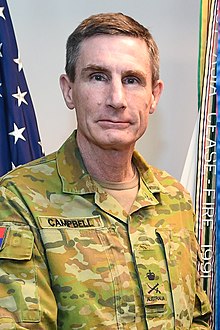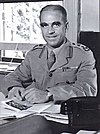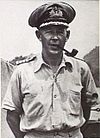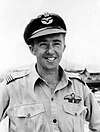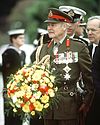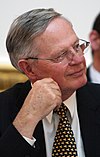Chief of the Defence Force (Australia)
| Chief of the Defence Force | |
|---|---|
 | |
| Style | Admiral General Air Chief Marshal |
| Abbreviation | CDF |
| Member of | Australian Defence Force |
| Reports to | Minister for Defence |
| Term length | Four years[1] |
| Formation | 23 March 1958 |
| First holder | Lieutenant General Sir Henry Wells |
| Deputy | Vice Chief of the Defence Force |
| Website | Official website |
The Chief of the Defence Force (CDF) is the highest-ranking and most senior military officer in the Australian Defence Force (ADF) and is the principal military advisor to the National Security Committee and the Minister for Defence. The current Chief of the Defence Force is General Angus Campbell, who took office on 6 July 2018.
Responsibilities[]
The CDF commands the ADF under the direction of the Minister for Defence and provides advice on matters that relate to military activity, including military operations.[2] In a diarchy, the CDF serves as co-chairman of the Defence Committee, conjointly with the Secretary of Defence, in the command and control of the Australian Defence Organisation.[3]
The CDF is the Australian equivalent position of what in NATO and the European Union is known as the Chief of Defence, in the United Kingdom is known as the Chief of the Defence Staff, and in the United States is known as the Chairman of the Joint Chiefs of Staff, although with the latter prohibited by law from having operational command authority over the US Armed Forces.[4]
Constitutionally, the Governor-General of Australia, is the de jure Commander-in-Chief of the Australian Defence Force. However, in practice, the Australian Government de facto exercises executive power via the Federal Executive Council.[5] The CDF is appointed by the Governor-General on the advice of his/her ministers. The appointment is politically neutral, as are all military positions, and not affected by a change of government.
Since 4 July 2014, the CDF is appointed for a fixed four-year term under the Defence Act (1903). Prior to this date, the appointment was for three years.[1] The position of CDF is notionally rotated between the Royal Australian Navy, the Australian Army and the Royal Australian Air Force. However, in practice this has not been the case; of eighteen appointees, nine have been from the Army, five from the Navy and four from the Air Force.[6] The current Chief of the Defence Force is General Angus Campbell.
During peacetime, the Chief of the Defence Force is the only four-star officer in the ADF (admiral, general, or air chief marshal). The CDF is assisted by the Vice Chief of the Defence Force (VCDF) and serves as the Chairman of the Chiefs of Service Committee, composed of the service chiefs: the Chief of Navy (CN), Chief of Army (CA), and Chief of Air Force (CAF), all of whom are three-star officers (vice admiral, lieutenant general, and air marshal), as is the VCDF.
History[]
Prior to 1958 there was no CDF or equivalent; a Chiefs of Staff Committee (COSC) existed but no separate position was established as its senior officer. Instead, the senior service chief served as Chairman of the Chiefs of Staff Committee.[7] In March 1958, Lieutenant General Sir Henry Wells was appointed Chairman, Chiefs of Staff Committee, a role independent of and notionally senior to the Army, Navy and Air Force chiefs. However, Wells and his successors did not command the Australian armed forces in any legal sense; the chairman had only an advisory role in the running of the separate services. In February 1976, COSC was dissolved and the new position of Chief of Defence Force Staff (CDFS) was created with command authority over the ADF. In October 1984 the position was renamed Chief of the Defence Force to more clearly reflect the role and its authority.[8]
Appointments[]
The following list chronologically records those who have held the post of Chief of the Defence Force or its preceding positions. The official title of the position at that period of time is listed immediately before the officers who held the role. The honours are as at the completion of the individual's term.
| No. | Portrait | Name | Took office | Left office | Time in office | Defence branch |
|---|---|---|---|---|---|---|
| Chairman, Chiefs of Staff Committee | ||||||
| 1 | Lieutenant General Sir Henry Wells KBE, CB, DSO (1898–1973) | 23 March 1958 | 22 March 1959 | 364 days | Army | |
| 2 | Vice Admiral Sir Roy Dowling KBE, CB, DSO (1901–1969) | 23 March 1959 | 27 May 1961 | 2 years, 65 days | Navy | |
| 3 | Air Chief Marshal Sir Frederick Scherger KBE, CB, DSO, AFC (1904–1984) | 28 May 1961 | 18 May 1966 | 4 years, 355 days | Air force | |
| 4 | General Sir John Wilton KBE, CB, DSO (1910–1981) | 19 May 1966 | 22 November 1970 | 4 years, 187 days | Army | |
| 5 | Admiral Sir Victor Smith AC, KBE, CB, DSC (1913–1998) | 23 November 1970 | 23 November 1975 | 5 years, 0 days | Navy | |
| 6 | General Frank Hassett AC, CB, CBE, DSO, LVO (1918–2008) | 24 November 1975 | 8 February 1976 | 76 days | Army | |
| Chief of Defence Force Staff | ||||||
| 6 | General Sir Frank Hassett AC, KBE, CB, DSO, LVO (1918–2008) | 9 February 1976 | 20 April 1977 | 1 year, 70 days | Army | |
| 7 | General Sir Arthur MacDonald KBE, CB (1919–1995) | 21 April 1977 | 20 April 1979 | 1 year, 364 days | Army | |
| 8 | Admiral Sir Anthony Synnot KBE, AO (1922–2001) | 21 April 1979 | 20 April 1982 | 2 years, 364 days | Navy | |
| 9 | Air Chief Marshal Sir Neville McNamara KBE, AO, AFC, AE (1923–2014) | 21 April 1982 | 12 April 1984 | 1 year, 357 days | Air force | |
| 10 | General Sir Phillip Bennett AC, KBE, DSO (born 1928) | 13 April 1984 | 25 October 1984 | 195 days | Army | |
| Chief of the Defence Force | ||||||
| 10 | General Sir Phillip Bennett AC, KBE, DSO (born 1928) | 26 October 1984 | 12 April 1987 | 2 years, 168 days | Army | |
| 11 | General Peter Gration AC, OBE (born 1932) | 13 April 1987 | 16 April 1993 | 6 years, 3 days | Army | |
| 12 | Admiral Alan Beaumont AC (1934–2004) | 17 April 1993 | 6 July 1995 | 2 years, 80 days | Navy | |
| 13 | General John Baker AC, DSM (1936–2007) | 7 July 1995 | 3 July 1998 | 2 years, 361 days | Army | |
| 14 | Admiral Chris Barrie AC (born 1945) | 4 July 1998 | 3 July 2002 | 3 years, 364 days | Navy | |
| 15 | General Peter Cosgrove AC, MC (born 1947) | 4 July 2002 | 3 July 2005 | 2 years, 364 days | Army | |
| 16 | Air Chief Marshal Angus Houston AC, AFC (born 1947) | 4 July 2005 | 3 July 2011 | 5 years, 364 days | Air force | |
| 17 | General David Hurley AC, DSC (born 1953) | 4 July 2011 | 30 June 2014 | 2 years, 361 days | Army | |
| 18 | Air Chief Marshal Mark Binskin AC (born 1960) | 30 June 2014 | 6 July 2018 | 4 years, 6 days | Air force | |
| 19 | General Angus Campbell AO, DSC | 6 July 2018 | Incumbent | 3 years, 206 days | Army | |
Living current and former Chiefs of the Defence Force[]
The honours listed below are updated as the former/current living chief receives them.
| Rank | Name | Born |
|---|---|---|
| General | Sir Philip Bennett AC, KBE, DSO | 27 December 1928 (age 93) |
| General | Peter Gration AC, OBE, FTSE | 6 January 1932 (age 90) |
| Admiral | Chris Barrie AC | 29 May 1945 (age 76) |
| General | The Honourable Sir Peter Cosgrove AK, CVO, MC | 28 July 1947 (age 74) |
| Air Chief Marshal | Sir Angus Houston AK, AFC | 9 June 1947 (age 74) |
| General | The Honourable David Hurley AC, DSC, FTSE | 26 August 1953 (age 68) |
| Air Chief Marshal | Mark Binskin AC | 20 March 1960 (age 61) |
| General | Angus Campbell AO, DSC |
Timeline[]

References[]
- ^ a b "New Australian Defence Force Command Team" (Press release). Office of the Prime Minister of Australia. 4 April 2014. Archived from the original on 5 November 2014. Retrieved 30 June 2014.
- ^ "Chief of the Defence Force – Roles and Responsibilities". Department of Defence. Retrieved 8 January 2016.
- ^ "The Secretary and Chief of the Defence Force – "the Diarchy"". Department of Defence. Retrieved 8 January 2016.
- ^ [1] 10 USC 152. Chairman: appointment; grade and rank
- ^ "Federal Executive Council Handbook". Department of the Prime Minister and Cabinet. Commonwealth of Australia. September 2009. ISBN 0-9752387-2-8. Archived from the original on 27 April 2015. Retrieved 7 January 2015.
- ^ "Chief of the Defence Force: Previous Chiefs". Department of Defence. Archived from the original on 30 January 2009. Retrieved 29 March 2008.
- ^ Rowell, Full Circle, p. 178
- ^ Horner, David (2002). "The Evolution of Australian Higher Command Arrangements". Command Papers. Canberra: Centre for Defence Leadership Studies, Australian Defence College. Archived from the original on 16 July 2012.
External links[]
- Australian Government. "Department of Defence". Commonwealth of Australia.
- "Defence Organisational Structure Chart" (PDF). Department of Defence. Commonwealth of Australia. 21 September 2015.
- Leadership of the Australian Defence Force
- Military appointments of Australia
- Australian generals
- Royal Australian Navy admirals
- Royal Australian Air Force air marshals
- Chiefs of the Defence Force (Australia)
- Chiefs of defence
